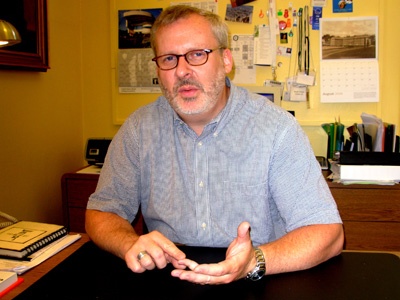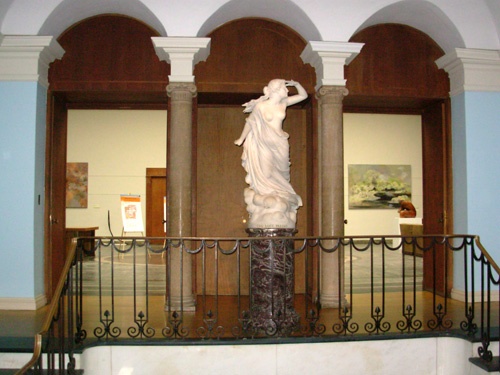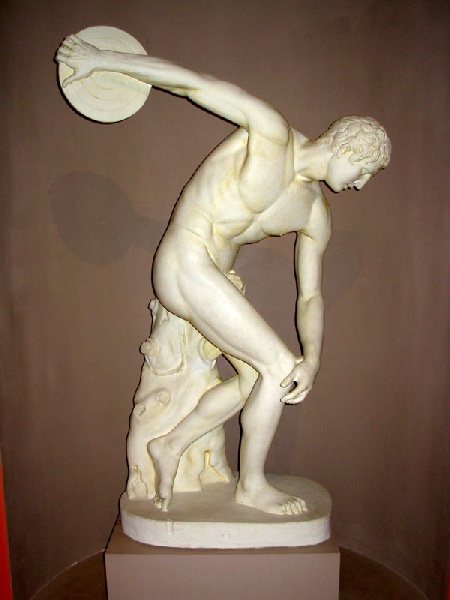Berkshire Museum Launches $9 Million Capital Campaign
Stuart Chase Outlines Dramatic Changes
By: Charles Giuliano - Aug 16, 2006

Stuart Chase Berkshire Museum Director, Giuliano photos.

A family enjoys the museum's aquarium.

The elegant interior of the museum.

A plaster cast of Myron's "Discus Thrower."

A pile of insect legs featured in the "Bugs" exhibition.

The eclectic Berkshire Museum in Pittsfield, which combines, a small cinema, displays of natural science, a mini aquarium, plaster casts of classical Greek sculptures, special exhibitions such as those currently devoted to Bugs and Baseball, and a collection of American art, was founded in 1903, and well, kindah, looks it.
But for Stuart Chase, the charming, amusing, charismatic director of the museum, who hit the ground running in March of 2005, that mongrel image suits him just fine. It's not his first time being involved with a regional, multi purpose museum primarily mandated to providing education in the arts and sciences. He has a word for it "Collision" which is also a signifier of his vision of the museum. How best to make it unique and functional, a definition and mandate for an ambitious $9 million capital fund drive that was initiated by the museum's board prior to his arrival.
He also describes the museum as the centerpiece and anchor of the fast changing Pittsfield arts campus that is book ended by two stunning renovations, the $21 million Colonial Theatre and the Barrington Stage, with its $4 million upgrade. Add to this mix the emergence of the upscale Spice restaurant, which commands most of a city block, and a lot is happening in Pittsfield, which a decade ago, was pretty much dead in the water.
In addition to anchoring the Pittsfield arts campus, the Berkshire Museum is an interesting and unique complement to a well defined mix of area museums and historic sites from sprawling, avant-garde Mass MoCA, to the masterpieces of Impressionism in the Clark Art Institute, the scholarly and lively Williams College Museum of Art, or the popular illustrations of the Norman Rockwell Museum. As a family oriented institution the Berkshire Museum is thriving in its unique profile; which only promises to improve with a combination of new resources and overlapping theatre audiences. It is pragmatic to speak of a shift of the nexus of the art world from Southern Berkshire County to a radius from Stockbridge, Great Barrington and Lenox to North Adams and Williamstown with Pittsfield as the center.
Recently we met with Chase late on a Friday afternoon of a busy week to discuss these ambitious plans and their impact. Phase one of the renovation, $600,000 for a new roof, was completed in June of 2005. The next task is a $3 million climate control project as well as $1.5 million for renovation of the museum interior. Additionally, $500,000 is earmarked for educational facilities, $1.4 million for interactive galleries and $1 million for endowment. Part of the challenge is that the museum is locked into its footprint so all of the additional and upgraded space and programs have to be designed into the existing structure. With so much still affordable real estate (for just how long?) we asked about the possibility of acquiring additional raw space for special exhibitions and storage? While Chase acknowledged that it is a nice idea there is the task at hand to raise $9 million. It doesn't take a crystal ball to envision that Pittsfield will be very different a decade from now. While landlords were stuck with empty retail spaces not so long ago, hence Maggie Mailer's "Storefront Artists" which got a ton of press, there seems to be a phase of gentrification right now. This is an old story for artists who improve downtrodden areas and then get priced out.
But, according to Chase, Pittsfield which was down on its luck for a long time, when local industry downscaled or relocated, just went to sleep so the city is architecturally intact. Not like a lot of cities under similar circumstances which were gutted and uglified when they fell on hard times. In the case of the Colonial Theatre, for example, the space has been brought back to its former magnificence. Now it is the turn for the Berkshire Museum to get a bit of spit and polish. Strolling along the heart of the city last week felt very different from a year ago, and dramatically different from a couple of years back. Hey, it will never be picture postcard Stockbridge, but Pittsfield does have its own small city grit and charm. It's a place for doing business. Right now art business. Hopefully enough to sustain such entrepreneurs as Scott Langoneur and his ambitious and challenging Boreas Gallery. Recently I talked with a New York based artist who contemplates opening a Pittsfield art gallery. If development and foot traffic increase there is the potential to develop galleries to augment the strong presence of artist studios.
"I like the collision of art history and science," Chase said. "I've been in those fields in the past such as when I was working for the Museum of the South West in Midland, Texas. We had an art collection as well as a planetarium, mineral and fossil collection. I have always been involved in a combination of art and history with old house museums and Sturbridge Village and later as director of the Rockwell Museum, in Corning, New York. There is strength in combination. It is my theory of the Collision of art and science which are separated in academia. But that's not the real world where everything collides every day. In our every day life there is no such separation of art and science. What I love about the Berkshire Museum is that it is family oriented. We serve about 12,500 students each year from 53 schools in five states. Overall, we attract between 80,000 and 90,000 visitors each year."
And that can only get better with upgraded facilities and programming. The $3 million climate control renovation is crucial as without it no museum will loan objects for special exhibitions. This allows for traveling shows and more ambitious special exhibitions. As well as preserving a permanent collection of 20,000 to 30,000 objects. The museum is undertaking a major inventory and documentation that has unearthed exciting discoveries. Among the interests of Zenas Crane the founder of the museum were Hudson River landscapes and images of the West as well numerous Native American artifacts. He was a member of the Explorer's Club in New York and was a sponsor of the Admiral Byrd arctic expedition. Chase has been involved with contemporary Native American art since the 1980s. He would like to develop that aspect of the permanent collection. We plan to get together and discuss that topic in depth at a later time.
There is considerable pressure running a small and ambitious museum with just a $2.2 million annual budget. Not surprisingly there is a lot of turnover among museum directors. But Chase loves the Berkshires and skies as often as he can during the winter. The challenge, day to day, is having some 23 bosses, or board members to please. "The staff that works for me only has one boss to deal with," he said, but added that it is an active and committed board.
Just how does one become a museum director, I asked? It was surprising to hear him respond that, "I always wanted to become a museum director." He described the incredible art program of Palmer High School. In his class of 135 nine graduates went on to art schools. Among other languages the school offered classes in Polish. An inspiration and mentor was Charles di Mascola the head of the art department. Chase went on to Virginia Commonwealth University which he describes as having the best art department in the South. He enrolled in Museum Studies for which, remarkably, students are required to submit a portfolio.
As is common in the field he became a hands on curator and eventually museum director. He was with the Clark Art Institute and before that director of the Rockwell Museum prior to taking over at the Berkshire Museum. There is no substitute for experience. But more importantly the job requires vision, commitment and passion. He points out that a museum is also a business. Like any other business. And its business happens to be art. That's something for Pittsfield to think about as it redefines itself as an Arts City.






